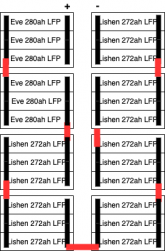Question: is it acceptable to create a battery made up of (2) 3p supercells of Eve 280ah LiFePO4 cells and (6) 3p supercells of 272ah Lishen LiFePO4 cells. See attached configuration image.
Details: I currently have an 8s configuration of Eve 280ah cells managed by an Electrodacus SBMS0. I'd like to expand this to a 3p8s configuration. I understand that, due to intentional choices in the way the SBMS0 works, it cannot communicate with another SBMS0 in any meaningful way. I also understand that it is expected that the battery managed by an SBMS0 present as a 3s-8s config. Finally, I intend to implement this in the method defined for the Electrodacus, with the SBMS0 in control of all charging/loads.
Currently, it is not possible to easily obtain 280ah Eve LiFePO4 cells due to recent changes in the marketplace. Lishen 272ah LiFePO4 cells are now common and relatively inexpensive. Their dimensions are similar enough that intermingling them should be approachable from a physical perspective. Two of the current Eve 280ah LiFePO4 cells are lower performing (but in spec). In the proposed configuration, those 2 cells would be scrapped, creating (2) 3p Eve supercells per the illustration.

Thanks!
Details: I currently have an 8s configuration of Eve 280ah cells managed by an Electrodacus SBMS0. I'd like to expand this to a 3p8s configuration. I understand that, due to intentional choices in the way the SBMS0 works, it cannot communicate with another SBMS0 in any meaningful way. I also understand that it is expected that the battery managed by an SBMS0 present as a 3s-8s config. Finally, I intend to implement this in the method defined for the Electrodacus, with the SBMS0 in control of all charging/loads.
Currently, it is not possible to easily obtain 280ah Eve LiFePO4 cells due to recent changes in the marketplace. Lishen 272ah LiFePO4 cells are now common and relatively inexpensive. Their dimensions are similar enough that intermingling them should be approachable from a physical perspective. Two of the current Eve 280ah LiFePO4 cells are lower performing (but in spec). In the proposed configuration, those 2 cells would be scrapped, creating (2) 3p Eve supercells per the illustration.

Thanks!


